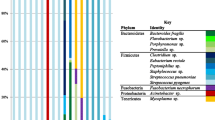Abstract
Fluorescence in situ hybridisation (FISH) targeted to ribosomal RNA is well established for studies in environmental microbiology. Initial applications of this technique in the field of medical microbiology showed that FISH is also a suitable means for the rapid, reliable and cultivation-independent identification of bacterial pathogens. In particular, for infectious diseases that follow a fulminant live-threatening course, such as sepsis or necrotising fasciitis (NF), a fast and reliable detection technique is of great importance. This study describes the development of an rRNA-targeted oligonucleotide set covering more than 95% of the pathogens associated with NF. These probes were tested with a broad collection of target and non-target organisms and found to be highly specific. Subsequently, the FISH approach was applied for the direct detection of bacterial pathogens in clinical samples. Two cases of NF and one case of streptococcal toxic shock syndrome (STSS) were analysed. FISH correctly identified almost all pathogens present in the samples examined within 2–3 h. However, Proteus mirabilis, which was identified in one sample by conventional methods was detected as a rod-shaped bacteria but could not be identified by FISH, since no specific probe was available for this particular organism. In contrast, identification of pathogens in these samples by conventional laboratory methods took 48–72 h. Furthermore, in one patient with pre-sampling antimicrobial therapy bacteria could not be grown from any of the samples. FISH unequivocally revealed the presence of Streptococcus pyogenes in affected tissue samples from this patient. In an experimental setting we demonstrated that FISH readily identifies S. pyogenes cells rendered non-cultivable by antibiotic treatment. Thus, FISH holds great promise for rapid identification of pathogens in fulminant infections such as NF, particularly in cases when pre-sampling antimicrobial therapy hampers culture of the causative agent.
Similar content being viewed by others
Author information
Authors and Affiliations
Additional information
Received: 16 December 1999
Rights and permissions
About this article
Cite this article
Trebesius, K., Leitritz, L., Adler, K. et al. Culture independent and rapid identification of bacterial pathogens in necrotising fasciitis and streptococcal toxic shock syndrome by fluorescence in situ hybridisation. Med Microbiol Immunol 188, 169–175 (2000). https://doi.org/10.1007/s004300000035
Issue Date:
DOI: https://doi.org/10.1007/s004300000035




